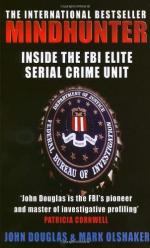
|
| Name: _________________________ | Period: ___________________ |
This test consists of 15 multiple choice questions and 5 short answer questions.
Multiple Choice Questions
1. What is the phrase "betting on raindrops rolling down the window" a metaphor for?
(a) Criminals that fail.
(b) Bettors that wager on anything because they love to bet.
(c) Serial killers that mess up.
(d) Bettors that are afraid to win.
2. Why did Douglas decide that Russell Odom and Clay Lawson were not criminally insane?
(a) They succeeded in their crime.
(b) They left no weapon at the crime scene.
(c) They left a letter at the crime scene.
(d) They returned to commit their crime a second time.
3. Where did Kemper live when he was interviewed in Chapter 6?
(a) California State Medical Facility.
(b) Seattle.
(c) A prison in New York.
(d) Alcatraz.
4. How old was Douglas when he taught road school?
(a) Forty-five.
(b) Twenty-five.
(c) Fifty-five.
(d) Thirty-two.
5. What did Douglas determine the ATKID killer was doing based on the location of a body after a false lead claimed the FBI would find a body there?
(a) The ATKID killer was a member of the FBI.
(b) The ATKID killer was psychic.
(c) The ATKID killer read press releases.
(d) The imposter was the ATKID killer.
6. What did Douglas look for in order to establish criminals from other people?
(a) A blank expression.
(b) Behavioral clues.
(c) Blonde Hair.
(d) A criminal record.
7. What was published in the book "Sexual Homicide: Patterns and Motives"?
(a) A history of the FBI.
(b) The secret identity of Charles Manson.
(c) Patterns and motives.
(d) The results of the prison interview study.
8. In Chapter 11, the field office was responsible for __________.
(a) Interviewing prison populations.
(b) Reporting to the president.
(c) Assigning police officers to crime scenes.
(d) Determining if the murders of young African American children were related.
9. What metaphor arose from a conversation with Douglas' mother about sex?
(a) Everybody loves their mother.
(b) Everybody has a soul.
(c) Everybody has a story.
(d) Everybody has a rock.
10. Richard Speck claimed he was not __________.
(a) A man.
(b) A murderer.
(c) A human.
(d) A serial killer.
11. In Chapter 8, what case did Douglas use to show how profiling narrows the suspect list?
(a) The case of Hank Simpson.
(b) The case of Christin Frank.
(c) The case of Bob Ewells.
(d) The case of Francine Elveson
12. What did Douglas want to be when he grew up?
(a) A carpenter.
(b) A trainer at Sea World.
(c) A layer.
(d) A vet.
13. Under Hoover, the Behavioral Science Unit was referred to as _______________.
(a) SU.
(b) The pit.
(c) BS.
(d) BSU.
14. In Chapter 6, to whom did Douglas compare Manson's upbringing?
(a) Kemper's upbringing.
(b) His father's upbringing.
(c) Bundy's upbringing.
(d) His own.
15. What did Jerry Brudos keep in his freezer as a souvenir of his crimes?
(a) An arm.
(b) A severed ear.
(c) A cut off foot.
(d) A pint of ice cream.
Short Answer Questions
1. What were there no signs of in the ATKID killings?
2. At the end of Chapter 7, what did the task force stay behind to learn?
3. When was the FBI authorized to become involved with the murders that took place in Atlanta in Chapter 11?
4. Who created the Applied Criminal Psychology course in 1972?
5. In Chapter 10, Douglas cited a murder case from Rome, Georgia, where a 12 year old was murdered. How was she killed?
|
This section contains 556 words (approx. 2 pages at 300 words per page) |

|




